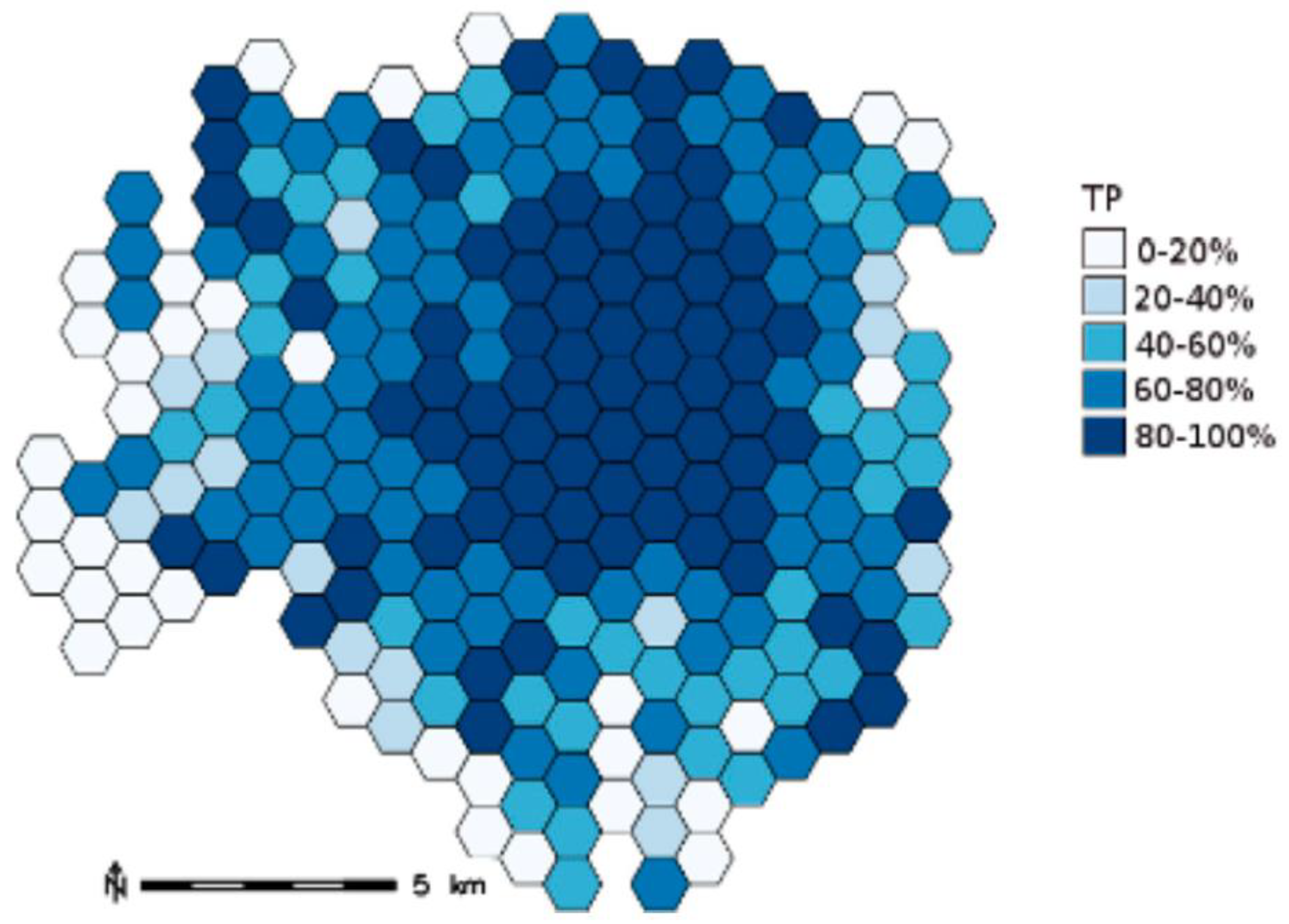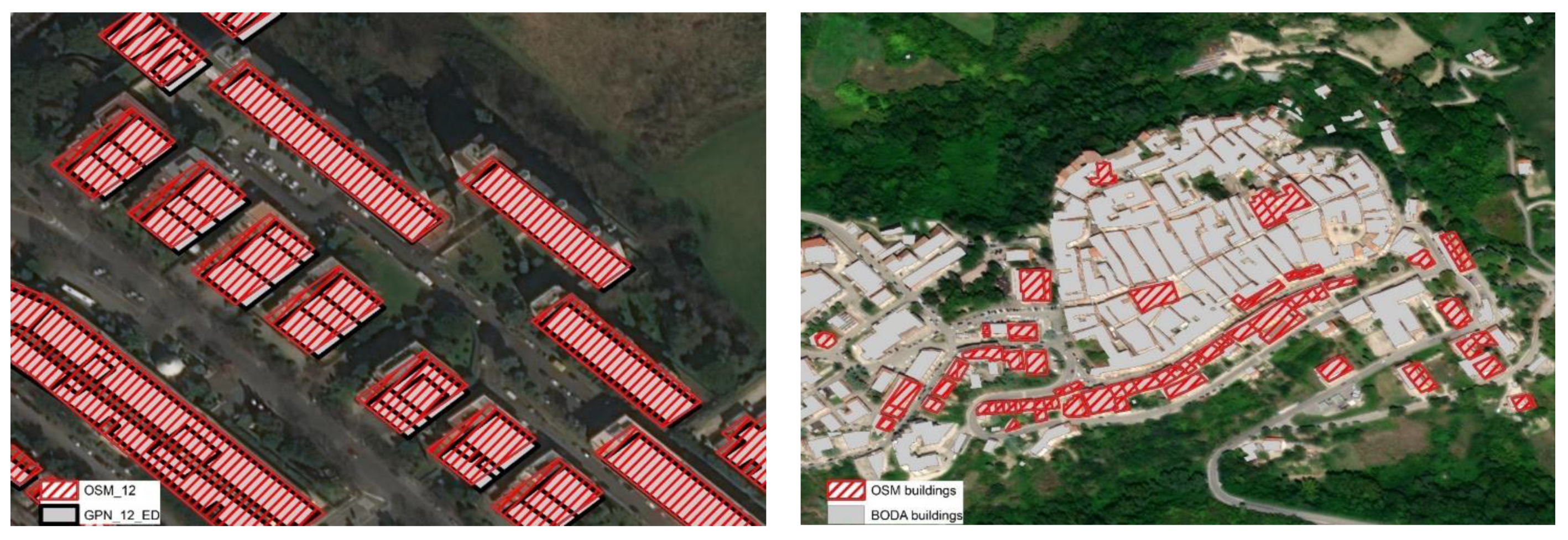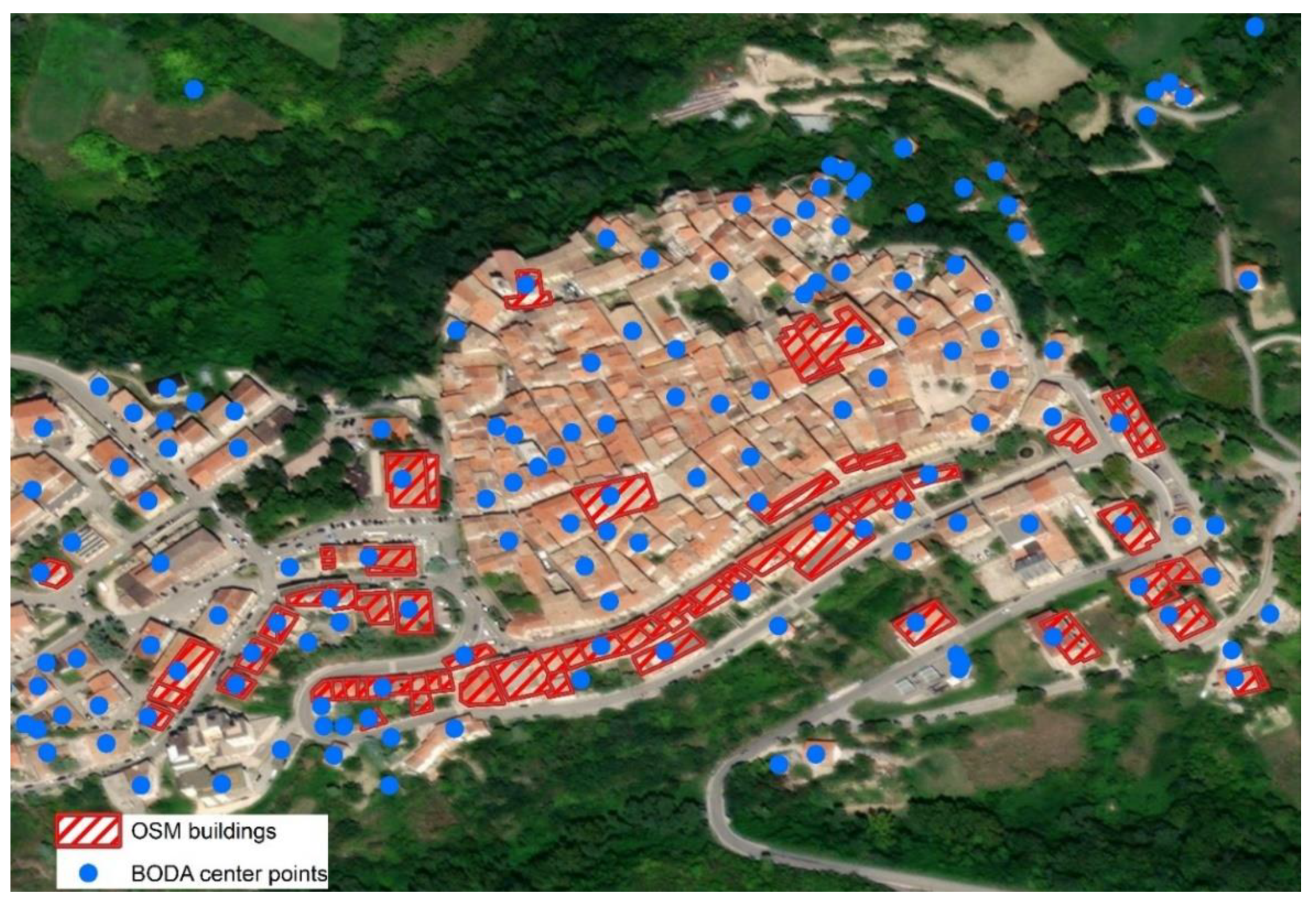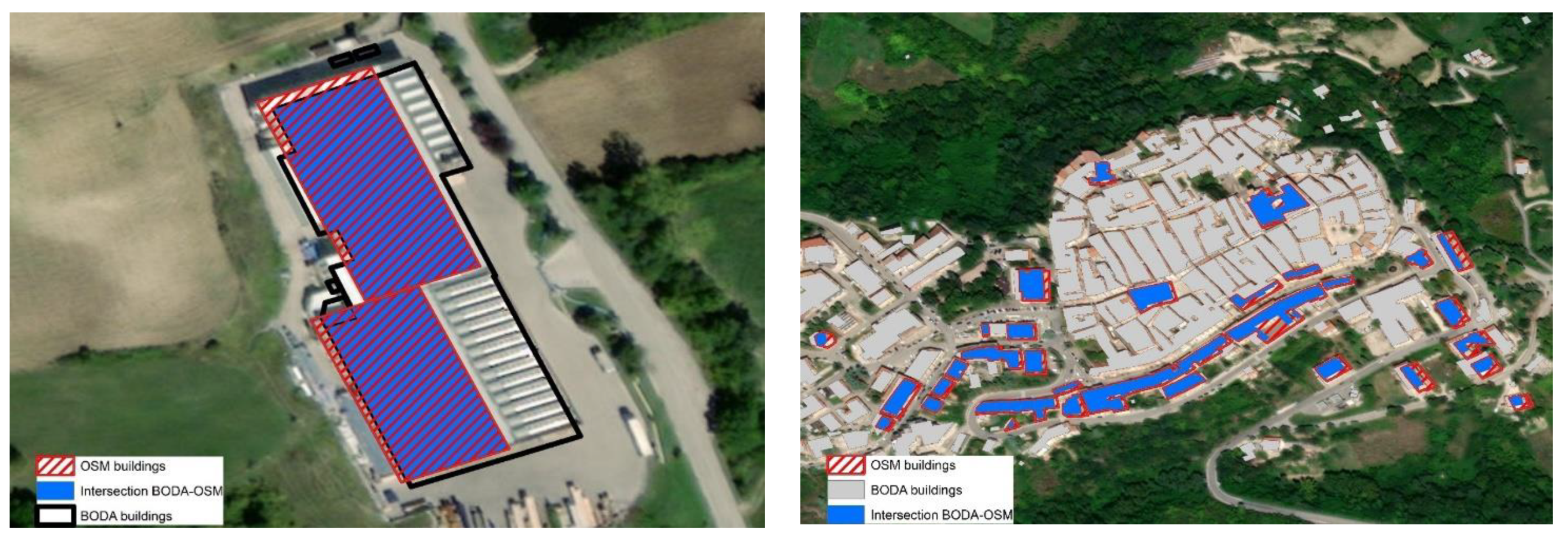Official Statistics, Building Censuses, and OpenStreetMap Completeness in Italy
Abstract
:1. Introduction
2. Materials and Methods
2.1. Study Area and Logical Framework
2.2. Buildings Open Data Archive (BODA)
2.3. The Spatial Distribution of Buildings Derived from Official Statistics in Italy
2.4. A Comparative Analysis of OSM and BODA Coverage in Italy
3. Results
3.1. Comparing the Coverage of Building Surveys Derived from Different Data Sources
3.1.1. Count-Based Comparison between OSM and BODA Databases
3.1.2. Building Centroid Superposition between OSM and BODA Databases
3.1.3. An “Object-Oriented” Approach Based on Polygon Intersection
4. Conclusions
Author Contributions
Funding
Institutional Review Board Statement
Informed Consent Statement
Data Availability Statement
Conflicts of Interest
References
- Girres, J.F.; Touya, G. Quality assessment of the French OpenStreetMap dataset. Trans. GIS 2010, 14, 435–459. [Google Scholar] [CrossRef]
- Mondzech, J.; Sester, M. Quality analysis of OpenStreetMap data based on application needs. Cartogr. Int. J. Geogr. Inf. Geovisualization 2011, 46, 115–125. [Google Scholar] [CrossRef]
- Fan, H.; Zipf, A.; Fu, Q.; Neis, P. Quality assessment for building footprints data on OpenStreetMap. Int. J. Geogr. Inf. Sci. 2014, 28, 700–719. [Google Scholar] [CrossRef]
- Ma, D.; Sandberg, M.; Jiang, B. Characterizing the heterogeneity of the OpenStreetMap data and community. ISPRS Int. J. Geo-Inf. 2015, 4, 535–550. [Google Scholar] [CrossRef]
- Goodchild, M. Citizens as Sensors: The world of volunteered geography. GeoJournal 2007, 69, 211–221. [Google Scholar] [CrossRef] [Green Version]
- Turner, A. Introduction to Neogeography. 2006. Available online: https://proquestcombo.safaribooksonline.com/0596529953 (accessed on 30 November 2021).
- Salvati, L. Towards a Polycentric Region? The Socio-economic Trajectory of Rome, an ‘Eternally Mediterranean’ City. Tijdschr. Voor Econ. En Soc. Geogr. 2014, 105, 268–284. [Google Scholar] [CrossRef]
- Basiouka, S.; Potsiou, C.; Bakogiannis, E. OpenStreetMap for cadastral purposes: An application using VGI for official processes in urban areas. Surv. Rev. 2015, 47, 1752270615Y.000. [Google Scholar] [CrossRef]
- Haklay, M.; Weber, P. OpenStreetMap: User-Generated Street Maps. IEEE Pervasive Comput. 2008, 7, 12–18. [Google Scholar] [CrossRef] [Green Version]
- Hecht, R. Measuring Completeness of Building Footprints in OpenStreetMap over Space and Time. ISPRS Int. J. Geo-Inf. 2013, 2, 1066–1091. [Google Scholar] [CrossRef]
- Zambon, I.; Colantoni, A.; Salvati, L. Horizontal vs vertical growth: Understanding latent patterns of urban expansion in large metropolitan regions. Sci. Total Environ. 2019, 654, 778–785. [Google Scholar] [CrossRef]
- Duvernoy, I.; Zambon, I.; Sateriano, A.; Salvati, L. Pictures from the other side of the fringe: Urban growth and peri-urban agriculture in a post-industrial city (Toulouse, France). J. Rural Stud. 2018, 57, 25–35. [Google Scholar] [CrossRef]
- Zambon, I.; Benedetti, A.; Ferrara, C.; Salvati, L. Soil matters? A multivariate analysis of socioeconomic constraints to urban expansion in Mediterranean Europe. Ecol. Econ. 2018, 146, 173–183. [Google Scholar] [CrossRef]
- Salvati, L.; Ciommi, M.T.; Serra, P.; Chelli, F.M. Exploring the spatial structure of housing prices under economic expansion and stagnation: The role of socio-demographic factors in metropolitan Rome, Italy. Land Use Policy 2019, 81, 143–152. [Google Scholar] [CrossRef]
- Pili, S.; Grigoriadis, E.; Carlucci, M.; Clemente, M.; Salvati, L. Towards sustainable growth? A multi-criteria assessment of (changing) urban forms. Ecol. Indic. 2017, 76, 71–80. [Google Scholar] [CrossRef]
- Kazemzadeh-Zow, A.; Zanganeh Shahraki, S.; Salvati, L.; Samani, N.N. A spatial zoning approach to calibrate and validate urban growth models. Int. J. Geogr. Inf. Sci. 2017, 31, 763–782. [Google Scholar] [CrossRef]
- Carlucci, M.; Chelli, F.M.; Salvati, L. Toward a new cycle: Short-term population dynamics, gentrification, and re-urbanization of Milan (Italy). Sustainability 2018, 10, 3014. [Google Scholar] [CrossRef] [Green Version]
- Fonte, C.C.; Patriarca, J.A.; Minghini, M.; Antoniou, V.; See, L.; Brovelli, M.A. Using OpenStreetMap to Create Land Use and Land Cover Maps Development of an Application. In Volunteered Geographic Information and the Future of Geospatial Data, edited by Cláudio Elízio Calazans Campelo, Michela Bertolotto, Padraig Corcoran; IGI Global: Amsterdam, The Netherlands, 2019; pp. 1100–1123. [Google Scholar]
- Ahmouda, A.; Hochmair, H.H.; Cvetojevic, S. Analyzing the effect of earthquakes on OpenStreetMap contribution patterns and tweeting activities. Geo-Spat. Inf. Sci. 2018, 21, 195–212. [Google Scholar] [CrossRef] [Green Version]
- Sui, D.Z. The Wwikification of GIS and its consequences: Or Angelina Jolie’s new tattoo and the future of GIS. Comput. Environ. Urban Syst. 2008, 32, 1–5. [Google Scholar] [CrossRef]
- Bajocco, S.; Ceccarelli, T.; Smiraglia, D.; Salvati, L.; Ricotta, C. Modeling the ecological niche of long-term land use changes: The role of biophysical factors. Ecol. Indic. 2016, 60, 231–236. [Google Scholar] [CrossRef]
- Salvati, L.; Zitti, M.; Sateriano, A. Changes in city vertical profile as an indicator of sprawl: Evidence from a Mediterranean urban region. Habitat Int. 2013, 38, 119–125. [Google Scholar] [CrossRef]
- Brovelli, M.A.; Minghini, M.; Molinari, M.E.; Zamboni, G. Positional accuracy assessment of the OpenStreetMap buildings layer through automatic homologous pairs detection: The method and a case study. ISPRS-Int. Arch. Photogramm. Remote Sens. Spat. Inf. Sci. 2016, 49, 615–620. [Google Scholar] [CrossRef] [Green Version]
- Franzini, M.; Annovazzi-Lodi, L.; Casella, V. Assessment of the Completeness of OpenStreetMap and Google Maps for the Province of Pavia (Italy). In Proceedings of the 6th International Conference on Geographical Information Systems Theory, Applications and Management, Prague, Czech Republic, 7–9 May 2020; pp. 270–277. [Google Scholar] [CrossRef]
- Ciommi, M.; Chelli, F.M.; Carlucci, M.; Salvati, L. Urban growth and demographic dynamics in southern Europe: Toward a new statistical approach to regional science. Sustainability 2018, 10, 2765. [Google Scholar] [CrossRef] [Green Version]
- Ciommi, M.; Chelli, F.M.; Salvati, L. Integrating parametric and non-parametric multivariate analysis of urban growth and commuting patterns in a European metropolitan area. Qual. Quant. 2019, 53, 957–979. [Google Scholar] [CrossRef]
- Bajocco, S.; Dragoz, E.; Gitas, I.; Smiraglia, D.; Salvati, L.; Ricotta, C. Mapping forest fuels through vegetation phenology: The role of coarse-resolution satellite time-series. PLoS ONE 2015, 10, e0119811. [Google Scholar] [CrossRef] [PubMed] [Green Version]
- Salvati, L.; Guandalini, A.; Carlucci, M.; Chelli, F.M. An empirical assessment of human development through remote sensing: Evidences from Italy. Ecol. Indic. 2017, 78, 167–172. [Google Scholar] [CrossRef]





| Region | Total Number of Buildings | Surface Area of Buildings | ||||||||
|---|---|---|---|---|---|---|---|---|---|---|
| Urban | Rural | Total | Urban (%) | Rural (%) | Urban | Rural | Total | Urban (%) | Rural (%) | |
| OSM archive | ||||||||||
| Piedmont | 688,877 | 450,615 | 1,139,492 | 60.4 | 39.6 | 194.52 | 106.82 | 301.34 | 64.5 | 35.4 |
| Aosta Valley | 37,094 | 34,868 | 71,962 | 51.6 | 48.4 | 7.80 | 5.14 | 12.93 | 60.3 | 39.7 |
| Lombardy | 1,239,227 | 273,940 | 1,513,167 | 81.9 | 18.1 | 424.04 | 102.20 | 526.24 | 80.6 | 19.4 |
| Trentino Alto Adige | 203,743 | 134,095 | 337,838 | 60.3 | 39.7 | 61.63 | 31.31 | 92.93 | 66.3 | 33.7 |
| Veneto | 1,664,300 | 793,503 | 2,457,803 | 67.7 | 32.3 | 349.98 | 157.48 | 507.46 | 69.0 | 31.0 |
| Friuli Venezia Giulia | 479,667 | 146,255 | 625,922 | 76.6 | 23.4 | 108.24 | 36.14 | 144.38 | 75.0 | 25.0 |
| Liguria | 350,365 | 171,120 | 521,485 | 67.2 | 32.8 | 65.66 | 15.98 | 81.64 | 80.4 | 19.6 |
| Emilia Romagna | 790,617 | 516,489 | 1,307,106 | 60.5 | 39.5 | 252.23 | 135.08 | 387.31 | 65.1 | 34.9 |
| Tuscany | 889,468 | 435,144 | 1,324,612 | 67.1 | 32.8 | 187.38 | 75.65 | 263.03 | 71.2 | 28.8 |
| Umbria | 68,474 | 41,221 | 109,695 | 62.4 | 37.6 | 27.33 | 12.14 | 39.48 | 69.2 | 30.8 |
| Marche | 92,096 | 66,264 | 158,360 | 58.2 | 41.8 | 32.05 | 18.41 | 50.47 | 63.5 | 36.5 |
| Latium | 491,448 | 183,719 | 675,167 | 72.8 | 27.2 | 171.02 | 69.44 | 240.46 | 71.1 | 28.9 |
| Abruzzo | 107,117 | 33,876 | 140,993 | 76.0 | 24.0 | 36.07 | 13.96 | 50.03 | 72.1 | 27.9 |
| Molise | 29,012 | 22,203 | 51,215 | 56.7 | 43.3 | 7.21 | 6.12 | 13.33 | 54.1 | 45.9 |
| Campania | 404,567 | 89,760 | 494,327 | 81.8 | 18.2 | 145.90 | 30.47 | 176.37 | 82.7 | 17.3 |
| Apulia | 698,835 | 896,943 | 1,595,778 | 43.8 | 56.2 | 227.63 | 131.55 | 359.18 | 63.4 | 36.6 |
| Basilicata | 72,385 | 85,295 | 157,680 | 45.9 | 54.1 | 17.74 | 15.87 | 33.61 | 52.8 | 47.2 |
| Calabria | 155,854 | 43,101 | 198,955 | 78.3 | 21.7 | 35.84 | 12.61 | 48.45 | 74.0 | 26.0 |
| Sicily | 529,782 | 119,042 | 648,824 | 81.6 | 18.3 | 117.77 | 35.70 | 153.46 | 76.7 | 23.3 |
| Sardinia | 317,302 | 273,544 | 590,846 | 53.7 | 46.3 | 102.31 | 55.36 | 157.67 | 64.9 | 35.1 |
| Italy | 9,310,230 | 4,810,997 | 14,121,227 | 65.9 | 34.1 | 2572.35 | 1067.43 | 3639.77 | 70.7 | 29.3 |
| BODA archive | ||||||||||
| Piedmont | 874,336 | 706,198 | 1,580,534 | 55.3 | 44.7 | 307.10 | 184.13 | 491.23 | 62.5 | |
| Aosta Valley | 39,858 | 39,917 | 79,775 | 50.0 | 50.0 | 9.20 | 5.78 | 14.98 | 61.4 | |
| Lombardy | 2,811,587 | 796,441 | 3,608,028 | 77.9 | 22.1 | 605.92 | 179.67 | 785.59 | 77.1 | |
| Trentino Alto Adige | 273,803 | 215,790 | 489,593 | 55.9 | 44.1 | 134.80 | 96.95 | 231.75 | 58.2 | |
| Veneto | 1,636,588 | 759,192 | 2,395,780 | 68.3 | 31.7 | 332.25 | 135.17 | 467.42 | 71.1 | |
| Friuli Venezia Giulia | 2,000,977 | 438,751 | 2,439,728 | 82.0 | 18.0 | 297.32 | 79.62 | 376.94 | 78.9 | |
| Liguria | 371,287 | 172,686 | 543,973 | 68.2 | 31.7 | 64.83 | 18.29 | 83.12 | 78.0 | |
| Emilia Romagna | 1,276,852 | 925,642 | 2,202,494 | 58.0 | 42.0 | 254.48 | 157.00 | 411.48 | 61.9 | |
| Tuscany | 1,367,632 | 674,136 | 2,041,768 | 67.0 | 33.0 | 178.55 | 76.38 | 254.93 | 70.0 | |
| Umbria | 278,379 | 245,528 | 523,907 | 53.1 | 46.9 | 51.03 | 33.19 | 84.22 | 60.6 | |
| Marche | 253,176 | 309,649 | 562,825 | 45.0 | 55.0 | 79.77 | 58.18 | 137.95 | 57.8 | |
| Latium | 941,431 | 851,858 | 1,793,289 | 52.5 | 47.5 | 209.32 | 173.33 | 382.65 | 54.7 | |
| Abruzzo | 320,073 | 304,192 | 624,265 | 51.3 | 48.7 | 66.96 | 39.07 | 106.04 | 63.1 | |
| Molise | 54,375 | 98,734 | 153,109 | 35.5 | 64.5 | 13.57 | 13.66 | 27.23 | 49.8 | |
| Campania | 800,823 | 730,989 | 1,531,812 | 52.3 | 47.7 | 228.36 | 164.43 | 392.80 | 58.1 | |
| Apulia | 508,183 | 919,489 | 1,427,672 | 35.6 | 64.4 | 175.37 | 103.75 | 279.12 | 62.8 | |
| Basilicata | 133,259 | 259,623 | 392,882 | 33.9 | 66.1 | 26.70 | 27.52 | 54.22 | 49.2 | |
| Calabria | 564,671 | 558,530 | 1,123,201 | 50.3 | 49.7 | 115.00 | 53.76 | 168.76 | 68.1 | |
| Sicily | 821,598 | 972,595 | 1,794,193 | 45.8 | 54.2 | 256.68 | 320.55 | 577.23 | 44.5 | |
| Sardinia | 327,017 | 345,696 | 672,713 | 48.6 | 51.4 | 100.77 | 45.86 | 146.64 | 68.7 | |
| Italy | 15,655,905 | 10,325,636 | 25,981,541 | 60.3 | 39.7 | 3507.99 | 1966.32 | 5474.31 | 64.1 | |
| Region | Total Number of Buildings | Surface Area of Buildings | ||||
|---|---|---|---|---|---|---|
| Urban | Rural | Total | Urban | Rural | Total | |
| Piedmont | 78.79 | 63.81 | 72.10 | 63.34 | 58.01 | 61.34 |
| Aosta Valley | 93.07 | 87.35 | 90.21 | 84.71 | 88.90 | 86.33 |
| Lombardy | 44.08 | 34.40 | 41.94 | 69.98 | 56.88 | 66.99 |
| Trentino Alto Adige | 74.41 | 62.14 | 69.00 | 45.72 | 32.29 | 40.10 |
| Veneto | 101.69 | 104.52 | 102.59 | 105.34 | 116.50 | 108.56 |
| Friuli Venezia Giulia | 23.97 | 33.33 | 25.66 | 36.41 | 45.39 | 38.30 |
| Liguria | 94.37 | 99.09 | 95.87 | 101.28 | 87.39 | 98.22 |
| Emilia Romagna | 61.92 | 55.80 | 59.35 | 99.11 | 86.04 | 94.13 |
| Tuscany | 65.04 | 64.55 | 64.88 | 104.95 | 99.04 | 103.18 |
| Umbria | 24.60 | 16.79 | 20.94 | 53.56 | 36.58 | 46.87 |
| Marche | 36.38 | 21.40 | 28.14 | 40.19 | 31.65 | 36.58 |
| Latium | 52.20 | 21.57 | 37.65 | 81.70 | 40.06 | 62.84 |
| Abruzzo | 33.47 | 11.14 | 22.59 | 53.87 | 35.73 | 47.18 |
| Molise | 53.36 | 22.49 | 33.45 | 53.11 | 44.79 | 48.93 |
| Campania | 50.52 | 12.28 | 32.27 | 63.89 | 18.53 | 44.90 |
| Apulia | 137.52 | 97.55 | 111.77 | 129.80 | 126.80 | 128.68 |
| Basilicata | 54.32 | 32.85 | 40.13 | 66.45 | 57.65 | 61.99 |
| Calabria | 27.60 | 7.72 | 17.71 | 31.16 | 23.45 | 28.71 |
| Sicily | 64.48 | 12.24 | 36.16 | 45.88 | 11.14 | 26.59 |
| Sardinia | 97.03 | 79.13 | 87.83 | 101.53 | 120.71 | 107.53 |
| Italy | 59.47 | 46.59 | 54.35 | 73.33 | 54.29 | 66.49 |
| Region | BODA Buildings in OSM Archive | BODA Building Overlap with OSM | ||||
|---|---|---|---|---|---|---|
| Urban | Rural | Total | Urban | Rural | Total | |
| Piemonte | 47.2 | 38.5 | 43.4 | 45.9 | 38.3 | 43.0 |
| Aosta Valley | 64.1 | 51.4 | 58.0 | 60.2 | 47.3 | 55.2 |
| Lombardy | 41.7 | 30.5 | 39.4 | 55.3 | 35.5 | 50.8 |
| Trentino Alto Adige | 64.8 | 47.2 | 57.2 | 35.5 | 19.8 | 29.0 |
| Veneto | 80.7 | 74.1 | 78.6 | 77.3 | 70.3 | 75.2 |
| Friuli Venezia Giulia | 88.9 | 84.9 | 88.2 | 58.0 | 50.3 | 56.4 |
| Liguria | 93.5 | 92.7 | 93.2 | 82.3 | 65.9 | 78.7 |
| Emilia Romagna | 77.3 | 62.6 | 71.2 | 80.8 | 67.2 | 75.6 |
| Tuscany | 74.8 | 59.6 | 69.9 | 80.4 | 63.8 | 75.4 |
| Umbria | 26.7 | 13.3 | 20.5 | 37.7 | 20.3 | 30.8 |
| Marche | 28.5 | 18.4 | 23.0 | 27.7 | 19.7 | 24.3 |
| Latium | 43.4 | 16.7 | 30.8 | 54.9 | 26.0 | 41.8 |
| Abruzzo | 24.0 | 8.1 | 16.4 | 33.4 | 20.2 | 28.5 |
| Molise | 29.5 | 13.4 | 19.1 | 33.7 | 24.1 | 28.9 |
| Campania | 35.2 | 8.2 | 22.4 | 43.7 | 11.4 | 30.1 |
| Apulia | 93.8 | 78.7 | 83.9 | 96.0 | 85.1 | 91.9 |
| Basilicata | 36.0 | 0.0 | 36.0 | 55.0 | 51.8 | 53.4 |
| Calabria | 16.6 | 5.7 | 11.1 | 19.8 | 13.3 | 17.7 |
| Sicily | 28.8 | 8.8 | 17.8 | 33.1 | 8.1 | 19.2 |
| Sardinia | 83.4 | 71.1 | 77.0 | 79.7 | 97.9 | 85.3 |
| Italy | 58.3 | 40.7 | 51.5 | 57.4 | 37.2 | 50.2 |
Publisher’s Note: MDPI stays neutral with regard to jurisdictional claims in published maps and institutional affiliations. |
© 2021 by the authors. Licensee MDPI, Basel, Switzerland. This article is an open access article distributed under the terms and conditions of the Creative Commons Attribution (CC BY) license (https://creativecommons.org/licenses/by/4.0/).
Share and Cite
Salvucci, G.; Salvati, L. Official Statistics, Building Censuses, and OpenStreetMap Completeness in Italy. ISPRS Int. J. Geo-Inf. 2022, 11, 29. https://doi.org/10.3390/ijgi11010029
Salvucci G, Salvati L. Official Statistics, Building Censuses, and OpenStreetMap Completeness in Italy. ISPRS International Journal of Geo-Information. 2022; 11(1):29. https://doi.org/10.3390/ijgi11010029
Chicago/Turabian StyleSalvucci, Gianluigi, and Luca Salvati. 2022. "Official Statistics, Building Censuses, and OpenStreetMap Completeness in Italy" ISPRS International Journal of Geo-Information 11, no. 1: 29. https://doi.org/10.3390/ijgi11010029
APA StyleSalvucci, G., & Salvati, L. (2022). Official Statistics, Building Censuses, and OpenStreetMap Completeness in Italy. ISPRS International Journal of Geo-Information, 11(1), 29. https://doi.org/10.3390/ijgi11010029






